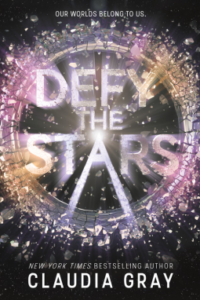
Claudia Gray
Little, Brown Books for Young Readers
Published April 4, 2017

Amazon | Barnes & Noble | Goodreads
About Defy the Stars
She’s a soldier.
Noemi Vidal is a seventeen years old and sworn to protect her planet, Genesis. She’s willing to risk anything—including her own life. To their enemies on Earth, she’s a rebel.
He’s a machine.
Abandoned in space for years, utterly alone, Abel has advanced programming that’s begun to evolve. He wants only to protect his creator, and to be free. To the people of Genesis, he’s an abomination.
Noemi and Abel are enemies in an interstellar war, forced by chance to work together as they embark on a daring journey through the stars. Their efforts would end the fighting for good, but they’re not without sacrifice. The stakes are even higher than either of them first realized, and the more time they spend together, the more they’re forced to question everything they’d been taught was true.
My Review
I started this book with pretty high hopes. Right away, I liked the third person present tense writing. It kept the story feeling immediate, and especially made sense to me in Abel’s scenes. I loved both Noemi and Abel straight from the start. Like Abel, I respected Noemi’s willingness to sacrifice herself to save others and her love for her best friend Esther. I felt a bit skeptical of whether Abel’s scenes would really seem like AI or whether they would feel too human. Actually, I really liked him a lot, and I think the internal experiences—rational breakdowns and examinations of emotions worked really well. I liked that over time he experienced character development, too.
The plot took me to some places I didn’t expect. I liked that unexpectedness. On the other hand, I really struggled with the ending. I don’t want to give anything away. But. The whole story had a certain goal and then by the end it felt like that goal sort of got dropped. I didn’t really understand a couple of the details that led up to the goal being abandoned. I mean, I feel like I understood some of the reasons, but I don’t know. It was weird. It felt like a really solid story that took a detour at the end to allow for setting up the rest of the series. Normally that doesn’t bother me—I liked the characters so I’m not sad at all that there may be other adventures, but it felt a little bit like a bait and switch or something.
Still, I’m not at all sorry that I read it. I loved getting to explore so much of the intricate story world Gray created and her masterful characters had me hooked from the first page to the last.
If you liked the recent movie adaptation of Ender’s Game or Ex Machina, you want to add this book to your list. I think fans of Hayley Stone’s Machinations would also find this book appealing.
Cultural Elements
Noemi is Latina. Abel has the appearance of a white male.
Profanity/Crude Language Content
Strong profanity used infrequently.
Romance/Sexual Content
Kissing between male and female. When it becomes clear Noemi and Abel will need money to carry out their plan, he offers to sell himself into prostitution, since he has been programmed with the ability to perform those activities. Noemi feels horrified by that idea and refuses to ask him to do such a thing, even though she still considers him a machine. At one point he offers to have sex with her, reasoning that since they are alone and have time to kill, and it would provide her with a form of release, it might be helpful. Noemi tells him her faith mandates that she not have casual sex.
Spiritual Content
On Noemi’s planet, Genesis, faith is of high value. People of all different faiths live together in harmony. Noemi herself is Catholic but has always struggled with her faith. Sometimes she knows she should pray and instead, she feels doubt. She keeps her faith through the story.
Violent Content
Noemi helps a fellow soldier with grave injuries. Abel and Noemi witness a terrorist attack at a celebration.
Drug Content
None.
Save